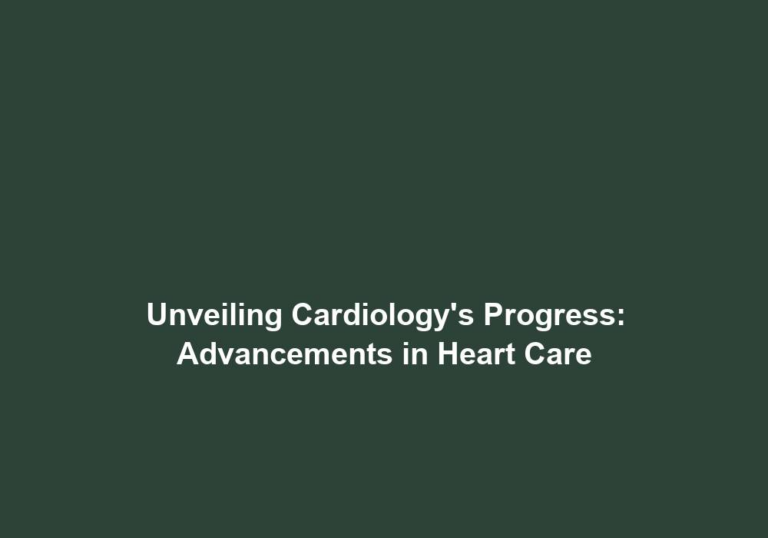Gentle Heart Care: Non-Invasive Cardiology Innovations
The field of cardiology has witnessed remarkable advancements over the years, particularly in the realm of non-invasive procedures. With a growing emphasis on patient comfort and safety, non-invasive cardiology innovations provide effective solutions for diagnosing and treating various heart conditions without the need for surgery or invasive interventions. In this article, we will explore some of the significant breakthroughs and advancements in the field of non-invasive cardiology, highlighting their benefits and significance in providing gentle heart care.
The Evolution of Non-Invasive Cardiology
Non-invasive cardiology techniques have revolutionized the way heart conditions are diagnosed and managed. These innovative procedures utilize advanced technology and imaging techniques to provide accurate assessments of the heart’s structure and function, allowing healthcare professionals to make informed decisions regarding patient care.
Over the years, non-invasive cardiology has evolved from simple diagnostic tools to sophisticated imaging techniques that offer a comprehensive understanding of the heart’s health. The introduction of echocardiography, stress testing, cardiac MRI, CT angiography, and percutaneous coronary intervention (PCI) has significantly enhanced the diagnosis and treatment of heart conditions.
Echocardiography, for example, is a widely used non-invasive imaging technique that utilizes ultrasound waves to generate real-time images of the heart. This procedure provides valuable information about the heart’s structure, function, and blood flow, aiding in the diagnosis of various cardiac conditions such as valve abnormalities, heart failure, and congenital heart defects.
Stress testing, also known as exercise testing, helps evaluate the heart’s performance during physical exertion. This non-invasive procedure involves monitoring the heart’s response to controlled exercise, usually on a treadmill or stationary bike. By observing changes in heart rate, blood pressure, and electrocardiogram patterns, healthcare professionals can assess the heart’s ability to handle stress and identify any underlying conditions.
Cardiac Magnetic Resonance Imaging (MRI) is another groundbreaking non-invasive imaging technique that uses powerful magnets and radio waves to create detailed images of the heart. This innovative technology allows healthcare professionals to visualize the heart’s structure, function, and blood flow with exceptional clarity. Cardiac MRI is particularly useful in assessing heart muscle viability, detecting heart tumors, and evaluating congenital heart diseases.
CT angiography combines computed tomography (CT) scanning with the injection of a contrast dye to provide detailed images of the heart’s blood vessels. This non-invasive procedure enables healthcare professionals to assess the structure of the blood vessels and detect any blockages or narrowing that may impede blood flow. CT angiography plays a crucial role in diagnosing coronary artery disease and guiding subsequent treatment decisions.
Percutaneous Coronary Intervention (PCI), commonly known as angioplasty, is a non-invasive procedure used to treat narrowed or blocked coronary arteries. During PCI, a thin tube called a catheter is inserted into the affected artery, and a small balloon is inflated to widen the vessel and improve blood flow. In some cases, a stent may also be placed to keep the artery open. This procedure helps alleviate symptoms of coronary artery disease and restore blood supply to the heart muscle.
Benefits of Non-Invasive Cardiology
The benefits of non-invasive cardiology are numerous, making it a preferred approach for both patients and healthcare providers. Some of the key advantages include:
- Minimal discomfort: Non-invasive procedures eliminate the need for surgical incisions, reducing pain and discomfort for patients. This is particularly beneficial for individuals who are not suitable candidates for invasive interventions.
Non-invasive cardiology techniques prioritize patient comfort by eliminating the need for surgical incisions. Patients experience minimal discomfort compared to invasive procedures, which often involve significant post-operative pain and longer recovery times. The absence of incisions also reduces the risk of infection and bleeding, making non-invasive cardiology a safer option for patients.
- Reduced risk of complications: By avoiding invasive procedures, patients are at a lower risk of experiencing complications such as infections, bleeding, or adverse reactions to anesthesia.
Invasive interventions carry inherent risks, including the potential for infections, bleeding, and adverse reactions to anesthesia. Non-invasive cardiology techniques significantly reduce these risks, ensuring a safer experience for patients. The elimination of invasive procedures also minimizes the risk of complications associated with wound healing and scarring.
- Faster recovery: Non-invasive treatments often involve shorter recovery times compared to their invasive counterparts. Patients can resume their normal activities sooner, leading to improved overall quality of life.
Non-invasive cardiology procedures generally have shorter recovery times, allowing patients to return to their daily activities more quickly. This not only improves patients’ quality of life but also reduces the economic burden associated with prolonged hospital stays and post-operative care. Patients can regain their independence and productivity sooner, resulting in a faster return to their normal routine.
- Non-invasive monitoring: Certain non-invasive techniques allow for continuous monitoring of cardiac health, enabling healthcare professionals to detect and address potential issues promptly.
Non-invasive monitoring techniques, such as echocardiography and cardiac MRI, provide healthcare professionals with real-time information about the heart’s structure, function, and blood flow. This continuous monitoring allows for early detection of abnormalities or changes in the heart’s health, facilitating timely interventions and preventing further complications. Non-invasive monitoring is particularly beneficial for patients with chronic heart conditions who require ongoing assessment and management.
- Cost-effective: Non-invasive procedures generally incur lower healthcare costs compared to invasive interventions. This makes it a more accessible option for patients, contributing to improved healthcare affordability.
Non-invasive cardiology procedures are often more cost-effective than invasive interventions. They require fewer resources, shorter hospital stays, and lower post-operative care costs. The reduced financial burden makes non-invasive cardiology a viable option for a broader range of patients, ensuring equitable access to high-quality heart care.
Key Innovations in Non-Invasive Cardiology
1. Echocardiography
Echocardiography is a widely used non-invasive imaging technique that utilizes ultrasound waves to generate real-time images of the heart. This procedure provides valuable information about the heart’s structure, function, and blood flow, aiding in the diagnosis of various cardiac conditions such as valve abnormalities, heart failure, and congenital heart defects.
In recent years, echocardiography has seen significant advancements, including the introduction of 3D and 4D imaging. These techniques provide a more detailed and comprehensive visualization of the heart, allowing for better assessment of cardiac abnormalities and improved treatment planning. The integration of artificial intelligence algorithms further enhances the accuracy and efficiency of echocardiographic analysis, enabling healthcare professionals to make precise diagnoses and develop personalized treatment strategies.
2. Stress Testing
Stress testing, also known as exercise testing, helps evaluate the heart’s performance during physical exertion. This non-invasive procedure involves monitoring the heart’s response to controlled exercise, usually on a treadmill or stationary bike. By observing changes in heart rate, blood pressure, and electrocardiogram patterns, healthcare professionals can assess the heart’s ability to handle stress and identify any underlying conditions.
Advancements in stress testing techniques have led to the development of more sophisticated monitoring systems, such as wearable devices. These devices enable continuous heart rate monitoring during daily activities, providing a comprehensive assessment of the heart’s response to various stressors. The integration of wireless technology allows for remote monitoring, empowering patients to actively participate in their own cardiovascular health management. Stress testing has also become more specialized, with protocols tailored to specific patient populations, such as athletes or individuals with suspected coronary artery disease.
3. Cardiac Magnetic Resonance Imaging (MRI)
Cardiac MRI is a non-invasive imaging technique that uses powerful magnets and radio waves to create detailed images of the heart. This innovative technology allows healthcare professionals to visualize the heart’s structure, function, and blood flow with exceptional clarity. Cardiac MRI is particularly useful in assessing heart muscle viability, detecting heart tumors, and evaluating congenital heart diseases.
Recent advancements in cardiac MRI have focused on improving image quality and reducing scan times. The integration of motion correction techniques minimizes artifacts caused by patient movement, ensuring accurate and reliable imaging results. Additionally, the development of novel contrast agents enhances the visualization of specific cardiac structures and abnormalities, further improving diagnostic capabilities. Cardiac MRI is also being explored as a tool for guiding minimally invasive procedures, such as catheter-based interventions, offering real-time visualization and precise targeting.
4. CT Angiography
CT angiography is a non-invasive imaging procedure that combines computed tomography (CT) scanning with the injection of a contrast dye. This technique provides detailed images of the heart’s blood vessels, enabling healthcare professionals to assess their structure and detect any blockages or narrowing that may impede blood flow. CT angiography is an essential tool in diagnosing coronary artery disease and guiding subsequent treatment decisions.
Advancements in CT angiography have focused on improving image resolution and reducing radiation exposure. State-of-the-art CT scanners with higher detector configurations and faster scanning capabilities allow for more detailed visualization of the coronary arteries. The utilization of low-dose protocols and iterative reconstruction algorithms further minimizes radiation doses without compromising image quality. Additionally, the integration of artificial intelligence algorithms aids in the automated analysis of CT angiography images, improving efficiency and diagnostic accuracy.
5. Percutaneous Coronary Intervention (PCI)
Percutaneous Coronary Intervention, commonly known as angioplasty, is a non-invasive procedure used to treat narrowed or blocked coronary arteries. During PCI, a thin tube called a catheter is inserted into the affected artery, and a small balloon is inflated to widen the vessel and improve blood flow. In some cases, a stent may also be placed to keep the artery open. This procedure helps alleviate symptoms of coronary artery disease and restore blood supply to the heart muscle.
Advancements in PCI techniques have led to the development of drug-eluting stents, which release medication to prevent the re-narrowing of the treated artery. These stents have significantly reduced the need for repeat procedures and improved long-term outcomes for patients. The introduction of bioresorbable stents, which gradually dissolve over time, offers an alternative option for individuals who may require future interventions. Furthermore, the integration of intravascular imaging technologies, such as optical coherence tomography (OCT), provides real-time visualization of the treated artery, ensuring optimal stent placement and reducing the risk of complications.
The Future of Non-Invasive Cardiology
Non-invasive cardiology continues to advance at a rapid pace, promising even more remarkable innovations in the future. Researchers are exploring novel technologies such as 3D imaging, wearable devices for continuous heart monitoring, and artificial intelligence algorithms for improved diagnosis and treatment planning. These advancements hold the potential to further enhance patient care, making non-invasive cardiology an indispensable aspect of modern healthcare.
In the coming years, the integration of 3D imaging techniques, such as holography and virtual reality, will provide healthcare professionals with a more comprehensive understanding of the heart’s anatomy and pathology. This enhanced visualization will facilitate precise treatment planning and improve patient outcomes. Wearable devices, equipped with advanced sensors and artificial intelligence algorithms, will enable continuous monitoring of vital signs and prompt detection of cardiac abnormalities. These devices will empower individuals to actively participate in their cardiovascular health management, leading to early interventions and better long-term outcomes.
Artificial intelligence algorithms will play a significant role in non-invasive cardiology, assisting in the analysis of complex imaging data, risk stratification, and treatment optimization. Machine learning algorithms will learn from vast datasets and assist healthcare professionals in making accurate diagnoses, predicting disease progression, and personalizing treatment plans. The integration of artificial intelligence will streamline clinical workflows, reduce interpretation times, and improve overall efficiency in non-invasive cardiology practice.
In conclusion, non-invasive cardiology innovations have revolutionized the field of heart care, providing patients with safer, more comfortable alternatives to invasive procedures. With ongoing advancements, non-invasive techniques offer accurate diagnoses, effective treatments, and improved patient outcomes. Embracing these innovations in gentle heart care ensures that individuals receive prompt, precise, and compassionate cardiovascular care, ultimately leading to healthier hearts and lives.







